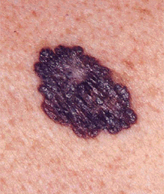Anti-PD-L1 Antibody MPDL3280A Active in Metastatic Melanoma
About one-third of patients with advanced cutaneous melanoma treated with MPDL3280A, an antibody against the programmed death 1 ligand (anti-PD-L1) showed a response in a phase I clinical trial.
Superficial spreading melanoma

About one-third of patients with advanced cutaneous melanoma treated with MPDL3280A, an antibody against the programmed death 1 ligand (anti-PD-L1) showed a response in a phase I clinical trial. The updated results were presented at the 10th International Congress of the Society for Melanoma Research (SMR) held November 17-20 in Philadelphia. The initial results were presented at the American Society of Clinical Oncology annual meeting earlier this year.
Jeffrey Sosman, MD, professor of medicine, Ingram Chair for Cancer Research and director of the Vanderbilt Melanoma Program at Vanderbilt University in Nashville, Tenn., presented the results.
The study, a phase I dose-escalation trial, included 45 patients with different types of melanoma. Of these, 35 patients had cutaneous melanoma, 5 patients had mucosal melanoma, 4 patients had ocular melanoma, and one patient had a melanoma of an unknown origin.
Eleven (33%) cutaneous melanoma patients responded to the treatment. The overall response rate for the pooled cutaneous, mucosal, and ocular melanoma patients was 28%. None of the four ocular melanoma patients treated had a response. Responses so far have been durable: 10 of the 11 responding patients continue to respond. The longest response time thus far is 10.5 months.
Most patients had rapid responses that were durable although some patients did show delayed responses, said Sosman.
Subanalysis showed that patients who had previously received an immunotherapy were more likely to respond to treatment with MPDL3280A (44%) compared with patients who had not previously been treated with immunotherapy (19%).
The 24-week progression-free survival is 41%.
A total of 61% of the patients had previously received at least one prior treatment for their metastatic disease and 36% had received a prior immunotherapy. No patient had previously received an immune checkpoint inhibitor such as ipilimumab or an anti-PD-1 antibody. Forty-four percent of the patients had wild-type BRAF melanoma and 24% had BRAF-mutated melanoma.
Patients were treated every 3 weeks for up to 16 cycles.
“Toxicities from treatment with MPDL3280A were quite mild,” said Sosman. The majority of toxicities were either grade 1 or grade 2. A total of six patients (13%) had grade 3 or 4 toxicities which were all laboratory abnormalities-elevated alanine aminotransferase (ALT) levels and elevated aspartate aminotransferase (AST) levels. The exception was one patient who experienced grade 3 fatigue.
“No patient had definitive pneumonitis or colitis,” said Sosman.
The interaction of PD-1 with its ligand, PD-L1 has been shown to negatively regulate T cell responses. Tumors can express PD-L1 as a way to dampen the immune response against tumor cells. In the current study, Dr. Sosman provided examples of analyses of patients’ tumor samples for infiltrating T cells. Those patients who responded to the anti-PD-L1 antibody were more likely to have presence of infiltrating T cells in their tumor compared with tumor samples from patients who did not respond to the antibody therapy. “Patients who did not respond had a paucity of T cells in the tumor and that remained the case before and after treatment,” said Sosman.
MPDL3280A is also being tested in patients with renal cell carcinoma and in those with non-small-cell lung cancer, in three separate phase II trials. A phase I combination trial of MPDL3280A plus vemurafenib, a targeted agent against V600E-mutated BRAF, is also ongoing.
Other anti-PD-1 or PD-L1 antibodies in development include nivolumab and MK-3475, both of which are also being tested in phase III metastatic melanoma clinical trials.